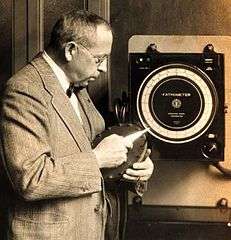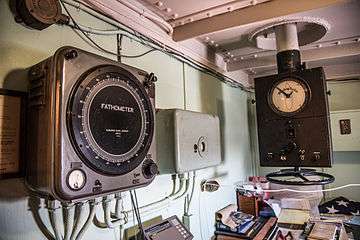Herbert Grove Dorsey

Herbert Grove Dorsey (April 24, 1876 – 1961) was an American engineer, inventor and physicist. He was principal engineer of the United States Coast and Geodetic Survey Radiosonic Laboratory in the 1930s. He invented the first practical fathometer, a water depth measuring instrument for ships.
Early life
Dorsey was born in Kirkersville, Ohio on April 24, 1876. His parents were Edwin Jackson and Mary Elma (Grove) Dorsey.[1]
Family
On June 21, 1900, Dorsey married Virginia Rowlett in Palmetto, Florida. Their children were Herbert Grove, Jr. and William Rowlett.[1]
Education
Dorsey received a Bachelor of Science degree from Johns Hopkins University in 1897. He did post-graduate work at Hopkins in 1897 and received a Master of Science honorary degree from Denison University in 1898. He did post-graduate work at Harvard University in 1900–1901 and earned a Ph. D. from Cornell University in 1908.[1]
Societies
He was a member of Beta Theta Pi.[1]
Career
Dorsey taught physics at the University of Maine from 1898–1900. He was head of the physics and electricity departments at the University of Florida from 1901–03 and at the University of Rochester from 1903–1904. Dorsey was assistant instructor in physics from 1904–1905, and instructor of physics from 1905–1910 at Cornell University.[1]
From 1910–1911, Dorsey worked as an electrical engineer in the research laboratory of Western Electric Company. He worked as an inventor at the National Cash Register Company from 1912–16. He was a physicist for the Hammond Radio Research Laboratory in Gloucester, Massachusetts from 1916–1921 and for the Submarine Signal Company from 1922–1925. Starting in 1926, he worked for the U.S. Coast and Geodetic Survey as the principal electrical engineer, continuing through the 1930s.[2]
Inventions
Some of his patented inventions were an automatic deposit box, 1908; an electric indicating system for railways, 1908; a telephone circuit, 1912; a telephone apparatus improvemnent, 1912; a device for graphically reproducing sound waves, 1912; a submarine mine, 1916; an electrical credit system, 1916; a safety device for electrical circuits, 1916; a submarine control system, 1918; a telegraphy device, 1921; and an auto chain applicator, 1921.[1]
Fathometer
Dorsey invented the practical fathometer in 1923, which is also referred to as the Dorsey Fathometer by the director of the U. S. Coast and Geodetic Survey in 1934.[3] It worked by sending a high pitched sound through the water. It traveled to the bottom at a known speed and returned an echo at the rate of four pings per second. This could then be measured and calculated as to the depth since sound travels at a precise speed in water. The "Fathometer" was so named by Dorsey because it measures fathoms.[4][5][6][7]
 Dorsey, circa 1930
Dorsey, circa 1930 Submarine Signal Company model
Submarine Signal Company model Fathometer aboard the Liberty ship SS John W. Brown.
Fathometer aboard the Liberty ship SS John W. Brown.
The Dorsey Fathometer instrument was used to get a precise measurement of water depth. It could measure depths from 8 to 3000 fathoms. The accuracy of the instrument was to within three inches and it could be measured in a millisecond. There were different models of the fathometer made initially by the Submarine Signal Company.[8] The indicator of the Dorsey Fathometer was a neon tube on a rotating disc. The instrument looked like a clock and was in the bridge of a ship. The transmitting and receiving electronics were usually below the deckhouse. Before this instrument a ship had slow down considerably or stop to take soundings to get the depth. With Dorsey's Fathometer a ship could go at full speed and get the measurements.[5][9][10][11]
Works
- Coefficients of linear expansion at low temperatures (1908)
- The Dorsey Fathometer Washington Academy of Sciences (1935)
References
- 1 2 3 4 5 6 Leonard, Downs & Lewis 1922, p. 376.
- ↑ "Biography of Dr. Herbert Grove Dorsey". National Oceanic & Atmospheric Administration (NOAA). NOAA Central Library. 2006. Retrieved November 19, 2015.
He invented the fathometer, and developed RAR on the Atlantic coast by floating hydrophone stations and Sono Radio Buoys.
- ↑ Patton, R.F. (1934), FIELD ENGINEERS BULLETIN – U.S. COAST & GEODETIC SURVEY (PDF), The Director, U. S. Coast and Geodetic Survey, p. 15, retrieved November 19, 2015,
It is with pleasure that I congratulate you on the successful demonstration of this development, and as a slight token of the appreciation of the Bureau, hereby direct that the instrument shall be designated as the Dorsey Fathometer, United States Coast and Geodetic Survey.
- ↑ "Echo Sounding / Early Sound Methods". National Oceanic & Atmospheric Administration (NOAA). NOAA Central Library. 2006.
In answer to the need for a more accurate depth registering device, Dr. Herbert Grove Dorsey, who later joined the C&GS, devised a visual indicating device for measuring relatively short time intervals and by which shoal and deep depths could be registered. In 1925, the C&GS obtained the very first Fathometer, designed and built by the Submarine Signal Company.
- 1 2 "1932 – Radio Talk on Echo Sounding by Dr. Herbert Grove Dorsey". National Oceanic and Atmospheric Administration. U.S. Department of Commerce NOAA. 2004. Retrieved November 19, 2015.
Herbert Grove Dorsey invented the fathometer.
- ↑ Kane 1997, p. 495.
- ↑ "Evolutions of Echo Soundings". Franke Institute for the Humanities. University of Chicago. 2015. Retrieved November 19, 2015.
Into this void swept Dr. Herbert Grove Dorsey. Dorsey tackled the problem of the difficulty of measuring shallow water by taking it upon himself to find a method of amplifying the sound waves. This led to the invention of the Fathometer, an electro-mechanical sounding device that integrated light as well as sound as a measurement of depths. Previously, no echo sounder had been able to measure much less than forty fathoms; Dorsey’s Fathometer, however, could measure as little as six fathoms due to the amplification of the sound waves.
- ↑ FIELD ENGINEERS BULLETIN No. 8 (PDF), U.S. COAST & GEODETIC SURVEY, 1934, p. 12, retrieved November 19, 2015
- ↑ "New fathometer used at full speed. Washington, D.C.,". Prints & Photographs Online Catalog. Library of Congress. May 7, 1937. Retrieved November 19, 2015.
Dr. Herbert Grove Dorsey of the U.S. Coast and Geodetic Survey has invented an instrument to secure the precise measurement.
- ↑ "Ships are guarded by "Fathometer"". Berkeley Daily Gazette. Berkeley, California. July 7, 1932. Retrieved November 19, 2015.
The instrument was invented by Dr. Herbert Grove Dorsey of the Coast and Geodetic Survey.
- ↑ Elsevier 2009, p. 7141.
Sources
- Elsevier (16 July 2009). International Encyclopedia of Human Geography: A 12-Volume Set. Elsevier. ISBN 978-0-08-044910-4.
In 1925, the first fathometer, known as the "312 fathometer," was developed by the Submarine Signal Company of Boston, Mass. This system allowed an operator to determine depth values by correlating the echo heard in his headset while noting the reading on a continuous-rotating flashing white-light circular depth scale. This system was more accurate and, unlike the previous system, could be operated while the vessel was underway. The first precision instrument deemed accurate enough for hydrographic work was the Dorsey fathometer #1, developed in 1933 and deployed on the Lydonia in 1934. This was truly a revolutionary system for its time as it incorporated the transmitter and receiver into one seawater-tolerant hull mounted unit called a transceiver, used supersonic operating frequency of 17 kHz, incorporated a mechanism for vibration dampening, had an operating range of from 3 to 900 feet
- Kane, Joseph Nathan (1997). Famous first facts: a record of first happenings, discoveries and inventions in the United States. New York City: H. W. Wilson.
The first fathometer to measure the depth of water was invented by Herbert Grove Dorsey of the U.S. Coast and Geodetic Survey, who received a patent on April 24, 1928. The device measured depth by means of a series of electrical sounds and light signals.
- Leonard, John William; Downs, Winfield Scott; Lewis, M. M. (1922). Who's who in Engineering. John W. Leonard Corporation.
External links
| Wikimedia Commons has media related to Herbert Grove Dorsey. |
- WorldCat Publications
- Find-A-Grave for Herbert Grove Dorset
- Herbert Grove Dorset – patent US1730411A
- Device for graphically reproducing sound-waves.
- Fathometer to measure the depth of water, 1928.
- Radio Talk on Echo Sounding by Dr. H. G. Dorsey